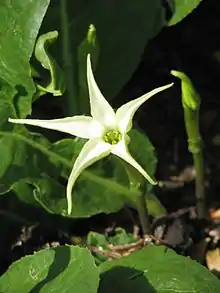Jaborosa
Jaborosa is a genus of flowering plants in the family Solanaceae, the nightshades. There are about 23 species,[1][2][3] all native to South America, where they are distributed from Peru to Patagonia. Most occur in the Andes.[3] Most can be found in Argentina[4] and ten are endemic to the country.[3]
| Jaborosa | |
|---|---|
 | |
| Jaborosa integrifolia | |
| Scientific classification | |
| Kingdom: | |
| (unranked): | |
| (unranked): | |
| (unranked): | |
| Order: | |
| Family: | |
| Genus: | Jaborosa |
| Species | |
|
about 23, see text | |
Description
Most Jaborosa are rhizomatous perennial herbs except J. bergii and J. sativa, which are annual or biennial.[3]
Ecology
J. rotacea is pollinated by flies, and J. runcinata is pollinated by moths.[3] Sphingid moths feed on the nectar of J. integrifolia.[4]
Chemistry
Like plants in several other Solanaceae genera, many Jaborosa species contain steroid-derived compounds called withanolides.[5] Many of the withanolides isolated from Jaborosa have been dubbed jaborosalactones. Some withanolides are phytotoxic, having effects on other plants such as inhibiting germination and radicle growth.[5] Some have antifeedant effects, deterring insects such as mealworms (Tenebrio molitor),[2] the Mediterranean fruit fly (Ceratitis capitata),[1] and the African cotton leafworm (Spodoptera littoralis)[6] from consuming the plant.
Diversity
- Jaborosa ameghinoi
- Jaborosa araucana
- Jaborosa bergii
- Jaborosa cabrerae[8]
- Jaborosa caulescens
- Jaborosa chubutensis
- Jaborosa integrifolia
- Jaborosa kurtzii
- Jaborosa lanigera
- Jaborosa leucotricha
- Jaborosa magellanica
- Jaborosa odonelliana
- Jaborosa oxipetala
- Jaborosa parviflora
- Jaborosa pinnata
- Jaborosa reflexa
- Jaborosa riojana
- Jaborosa rotacea
- Jaborosa runcinata
- Jaborosa sativa
- Jaborosa squarrosa
- Jaborosa volkmannii
References
- Tettamanzi, M. C., et al. (2007). A new antifeedant withanolide from Jaborosa lanigera. Zeitschrift für Naturforschung B 62(4) 573-76.
- Bonetto, G. M., et al. (1995). Novel withanolides from Jaborosa sativa. Journal of Natural Products 58(5) 705-11.
- Chiarini, F. E. and G. E. Barboza. (2008). Karyological studies in Jaborosa (Solanaceae). Botanical Journal of the Linnean Society 156(3) 467-78.
- Vesprini, J. L. and L. Galetto. (2000). The reproductive biology of Jaborosa integrifolia (Solanaceae): Why its fruits are so rare? Plant Systematics and Evolution 225(1-4), 15-28.
- Nicotra, V. E., et al. (2006). Phytotoxic withanolides from Jaborosa rotacea. Journal of Natural Products 69(5) 783-89.
- Vaccarini, C. E. and G. M. Bonetto. (2000). Antifeedant activity evaluation of withanolides from Jaborosa integrifolia. Molecules 5 422-23.
- Jaborosa. Solanaceae Source. Retrieved 6 July 2013.
- Barboza, G. (1986). Una nueva especie de Jaborosa (Solanaceae). Kurtziana 18 89-92.
| Wikimedia Commons has media related to Jaborosa. |